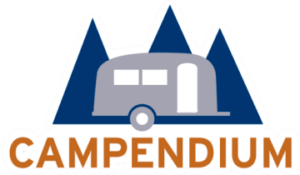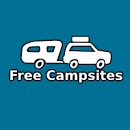If the call of the wild tugs at your heartstrings, but your wallet’s looking lean or you crave a little solitude, you’ve landed in the right place. While Recreation.gov is the go-to destination for nabbing sites at established campgrounds, there are plenty of other resources to help you find a great campsite – free of charge!
Whether you’re planning a road trip, getting started with van life, or just want to get away from the crowds, this guide will cover where you can camp for free in the United States, tools and resources to find free camping, and tips for staying safe on the road.
What Is Free Camping?
Traditionally, most campgrounds require a fee for camping, but free camping allows you to set up shop in your car, tent, camper van, or RV without payment or a reservation. Compared to traditional campgrounds or RV parks, authorities do not typically maintain free camping areas, and they may lack amenities such as restrooms, picnic tables, and hookups for water and electricity. Translation? You’ll need to arrive prepared, pack everything out, and leave the space better than you found it.
Types of Free Camping
Various terms are used to describe free camping. They all more or less refer to the same thing, with a few subtle distinctions. Let’s break it down.
Dispersed Camping
Unlike established campgrounds, dispersed camping allows you to camp just about anywhere on public lands, such as national forests and Bureau of Land Management (BLM) land. Rules and regulations for dispersed camping differ by public land area. Some locations will have guidelines on how far you need to be from roads or water sources, while others may impose campfire restrictions and limits on how long you can camp.
Boondocking
This is a term more commonly used among RVers and road trippers to refer to all manner of free camping. Boondocking is a catch-all phrase encompassing a range of free camping experiences; from posting up on BLM land to catching some Zs in a Walmart parking lot.
Read our complete guide to boondocking here.
Dry Camping
Dry camping is a type of free camping without fresh water, electric, or sewer hookups. You’re responsible for bringing your water supply and properly disposing of your waste. Oddly enough, the term might come off as redundant, given that most free campsites rarely offer potable water onsite.
Primitive Camping
Another name for backcountry camping. Primitive camping is synonymous with venturing into more secluded regions, without the modern conveniences found in established campgrounds – think drinkable water, picnic tables, pit toilets, showers, and waste disposal.
Stealth Camping
A term that became popular with the rise of van life as people parked their campervans in urban areas such as parks, parking lots, and scenic overlooks. Generally, stealth camping refers to situations where you don’t want to attract attention.
Where You Can Camp for Free in the United States
BLM Land
BLM land offers open access to everyone, featuring both developed and dispersed camping zones. The bulk of BLM land is concentrated in the western United States. Depending on your travel destination, you might either exclusively camp on BLM land or not encounter it at all.
Forest Service Land
Unlike BLM land, National Forest boundaries are usually displayed on navigation apps like Google Maps. You can also use resources like the National Forest Map Locator or explore state-specific information to learn more about the regulations and guidelines for camping in the jurisdiction you’re interested in.
State Parks
Don’t exclude state, city, and county parks from your search, as they sometimes allow camping for free or in dispersed areas.
Parking Lots
Another great option for free camping is overnight parking at business parking lots. A handful of businesses allow people to park in their lots overnight for free. Always check with the store manager first before settling in for the night. Businesses that usually allow overnight parking include Walmart, Costco, Sam’s Club, casinos, big box home improvement stores like Home Depot and Lowes, Cracker Barrel, 24-hour fitness centers, churches, and beach parking lots.
Rest Stops/Gas Stations
While rest stops can be useful in a pinch, you shouldn’t rely on them too much. In some states, overnight parking is not permitted in rest areas. Do your research ahead of time so you’re not getting an unpleasant surprise in the middle of the night. If you’re traveling in a state where overnight parking at rest stops isn’t allowed, or there aren’t any nearby, truck stops are another alternative. They’re a great place to catch some shut-eye, fuel up, stock up on snacks, and maybe even take a shower.
Residential and City Streets
Campervans and van lifers have the highest success rate with this method. City and residential streets can provide safe, no-cost overnight parking options. Avoid neighborhoods that may provoke suspicion from locals, like private communities, and keep your stay to a one-night maximum. Once you’re parked, stay inside your vehicle, make as little noise as possible, and pop open window coverings for added privacy.
How To Find Free Camping
You’ve aced the fundamentals of free camping! The question is, how do you locate these under-the-radar campsites? These free to low-cost tools are your ticket to discovering the camping haven you’ve been waiting for.
FreeRoam (Free)
 Devices: Desktop, Android
Devices: Desktop, Android
Why you’ll love it: FreeRoam is a free-to-use desktop and mobile app to help you find your next free campsite. The app offers Motor Vehicle Use Maps to help you navigate the extensive network of unpaved Forest Service and BLM roads, some inaccessible without AWD or 4WD. FreeRoam’s map layers even display cell coverage by network. Registering for a free account unlocks more features, including bookmarking campsites, placing destination pins, and planning multi-day adventures.
TheDyrt (Free/Paid)
 Devices: Desktop, iOS, Android
Devices: Desktop, iOS, Android
Why you’ll love it: With over a million user-submitted reviews, The Dyrt is the ultimate campground database powered by crowdsourced community data. Their listings include user reviews, campsite photos, info about amenities, as well as the ability to browse and read reviews offline. The Dyrt’s trip planning tool empowers users to meticulously outline their itinerary before setting out, with the added perk of seamlessly exporting routes to Google Maps. Dyrt PRO members enjoy up to 40% off camping fees at thousands of campgrounds around the country, plus incredible discounts on your favorite outdoor gear.
Campendium (Free)
 Devices: Desktop, iOS
Devices: Desktop, iOS
Why you’ll love it: For those without Androids, Campendium is a great alternative to FreeRoam available for iPhone only. The site offers thousands of camping options, ranging from free, dispersed sites to swanky RV parks. Campendium is mainly tailored toward RVers, especially if you’re hunting for those roomier dispersed campsites that won’t give your low-clearance ride a hard time. You can narrow down your perfect campsite by public lands, RV park, places for overnight RV parking, and sites with dump stations. If you’re all about keeping it simple and need your camping info pronto, Campendium is your go-to!
OnX Offroad (Paid)
 Devices: Desktop, Android, iOS
Devices: Desktop, Android, iOS
Why you’ll love it: For our overlanding friends or explorers with 4WD capabilities, OnX Offroad lets you discover the best off-road trails and filter them by trail difficulty, open/close dates, public and private land boundaries, and nearby campsites. Save maps for offline use, bookmark your favorite trips, and even sync your maps with CarPlay and Android Auto for a hassle-free driving experience. While there’s no free version of the app available, you can try it for seven days before upgrading to OnX Offroad’s Premium ($34.99) or Elite ($99.99) subscription.
As avid hikers and backcountry skiers, we use OnX Backcountry, and all of the OnX products have maps with private and public lands denoted.
FreeCampsites.net (Free)
 Devices: Desktop
Devices: Desktop
Why you’ll love it: Full transparency. This website is clunky and is in dire need of a UI overhaul. But it’s another reliable resource that helps you locate free campgrounds across the country. When searching for a site in a larger area, you can filter your results by access routes to the sites and facilities within and around your site. When you select a campsite, you’ll be given its GPS coordinates, user reviews, cell coverage information, and a local weather report.
Google Maps (Free)
![]() Devices: Desktop, Android, iOS
Devices: Desktop, Android, iOS
Why you’ll love it: If you know a spot that allows for free camping, you can switch over to Google Maps and zoom in on the area. Big, dispersed camping locations can sometimes have their own Google page with user reviews and photos to help you get a better idea of what the camping areas look like before you drive out.
iOverlander (Free)
 Devices: Desktop, Android, iOS
Devices: Desktop, Android, iOS
Why you’ll love it: In addition to finding campsites with this free-to-download Android and iOS app, iOverlander will show nearby water fill stations, gas stations, laundromats, showers, and other amenities that you won’t think you’ll need until you do, like the nearest hospital, auto shop, a cafe with wifi, or outdoor gear store. The UI for this app leaves something to be desired and isn’t as frequently updated as other user-driven apps like TheDyrt, but it’s worth having anyway if it’s free!
Outly (Free/Paid)
 Devices: Desktop, Android, iOS
Devices: Desktop, Android, iOS
Why you’ll love it: Outly’s web and mobile app does a great job showing the boundaries of government lands, national forests, and state lands, among others. The app will also display roads and indicate if they are paved, dirt, or 4WD only. A cool function of this app is the water feature filter. You can refine your search by natural springs, swimming holes, and waterfalls in the area. And if you upgrade to the app’s Pro tier, you can overlay cell coverage layers and create custom waypoints and trip routes. But keep in mind those sorts of features already come free to use in other apps on this list, like FreeRoam.
How To Stay Safe While Camping
Dispersed camping offers privacy and a break from crowds, but it’s not without risks, especially when you find yourself far from fellow campers and without cell service. Keep these camping safety tips in mind on your next trip:
- Don’t share your travel plans with strangers, and avoid posting your camp spots on social media. If you want to share, do it privately with folks you trust.
- Maintain a friendly, vigilant attitude toward your neighbors.
- Nobody wants to end up lost or stranded in an unfamiliar place. Download offline maps before you set off, and keep a paper map on hand as a backup.
- Research your destination in advance and note the dates of the reviews for the campsite. Proceed with caution if a campsite hasn’t been reviewed in a few years, as conditions may have changed since the last review.
- Let a friend or family member know where you’ll be camping and when you expect to return. Check-in often, especially if your plans change.
- Keep the driver’s seat clear and have a designated spot for your keys. Park where you can’t be blocked in and position your car so that it faces the road or exit.
- Assess your surroundings. Do you have more than one escape route in the event of an emergency?
- Check if there’s cell service where you’re camping in case you need to make an emergency call.
- Keep your doors locked, especially when you’re sleeping and always keep your valuables hidden.
- If you’re carrying a self-defense weapon, know how to use it (i.e., taser, pepper spray, knife, etc.)
- Most importantly, trust your gut. If you have a bad feeling about a campsite, leave. Never second guess your instincts – you can always find another campsite.

Ash Czarnota is a freelance writer based in Southern California with over 3,000 trail miles under her feet. She is the founder of Go Galavanting, an online community to celebrate adventurous women and highlight emerging thought leaders in the outdoor industry. A PCT alumni, Joshua Tree enthusiast and burgeoning climber, Ash uses her outdoor experiences to craft content that educates and inspires a rising generation of adventurers to embrace their inner wild. Connect with her on Instagram (@salty_millennial).
